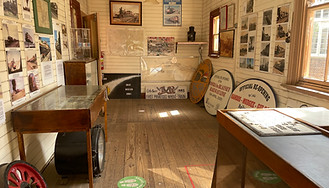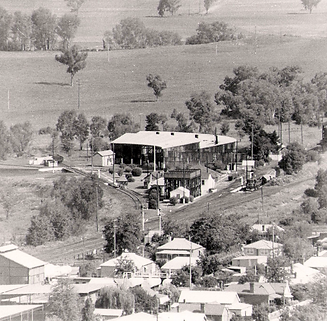
Cowra's Railway History

Regional development in nineteenth-century Australia depended on successful primary production and obtaining economic transport of produce to cities and ports, often initiated through the political activities of ‘railway leagues’.
Pastoralists first settled the Cowra region from the 1830s, and established a township that grew rapidly from the 1850s. Cowra subsequently developed as a major wheat-growing district; however, local roads were poor, and the region lacked reliable and economic transport to distant marketplaces.
A Cowra railway league therefore formed to argue the benefits that a Blayney-Murrumburrah cross-country railway line would bring to regional and state economies. Promoted by the local member for Carcoar, the line was approved by the Parkes-Robertson coalition government in 1881, and completed in 1887.
Political pressure from other railway leagues also led to construction of ‘pioneer lines’ from Cowra to Grenfell, Canowindra and Eugowra between 1901 and 1922. These lines greatly stimulated regional trade and agriculture by providing local railheads, and the resultant large-scale wheat cultivation transformed the regional landscape. Railways further developed the regional economy with efficient transport for passengers, manufactured products, mail and coal, and were a major employer in the area. The transport of farm machinery by rail also led to increased mechanisation of wheat cultivation. During the Second World War, the railways carried large troop numbers to serve at local military and prisoner camps. Railways remained the principal means of regional transport until local roads improved, and motor vehicles encroached on passenger and freight business from the 1950s.
To support local railway operations, the NSW Government Railways built a small locomotive depot in 1889 near Cowra Railway Station, initially employing around twenty-one men (including enginemen), and maintaining locomotives from other depots. As local traffic demands increased, the depot received a permanent allocation of locomotives, and employee numbers grew. NSWGR then built a much larger depot on the present site south of Cowra Railway Station in stages between 1921 and 1924.
By 1940, twenty-one locomotives were permanently allocated to Cowra Locomotive Depot with around one hundred employees. These numbers remained fairly constant until diesel traction was locally introduced in 1966, eliminating many jobs associated with steam locomotives. The depot received no permanent allocation of diesel locomotives and declined in importance, becoming a sub-depot of Bathurst in 1968. One steam locomotive remained in service at Cowra between 1968 and 1971, after which NSWGR serviced diesel locomotives and other rolling stock at the depot until its official closure in 1985.

De-ashing at the coal stage

The turntable circa 1925

Cowra Coal Stage
Cowra Rail Heritage Centre

From the time LVR arrived in Cowra in 1977 there has been a policy that in order to preserve the rollingstock it must first be protected.
LVR used parts of Cowra Locomotive Depot from 1978, and leased the entire depot site from 1985 for the conservation and operation of heritage trains based from Cowra. LVR also participated in a number of significant railway-based community events, until final closure of regional railway lines in 2009. Since then, LVR has managed Cowra Locomotive Depot as the Cowra Rail Heritage Centre to conserve and exhibit locomotives, rolling stock and other railway heritage items, and has actively promoted the depot as Cowra’s most significant industrial heritage site.
The first shed was started almost immediately which was large enough to hold three carriages side-by-side. This policy continued for 20 years resulting in the present complex, which can house over 55 carriages and engines undercover; The largest in New South Wales. Sadly there are still items in the open, some in desperate need of protection and some beyond help. There are plans for more covered storage but as always, money is the main enemy.
LVR has implemented a staged development plan that continues to deliver ongoing improvements to the site, including reconstruction of the 1947-built amenities block and restoration of the depot’s war memorial fountain. LVR has a continuing program to interpret of the site, focusing attention on stories associated with activities that once took place at the depot, and on the men who worked there.
LVR has three steam locomotives, 3237, 5367 and 3026 as well as a rare vertical boilered Harman Steam Crane. The 32 is currently based at our Orange East Fork depot, while others are on display in the roundhouse. There are five CPH diesel rail motors from the 1920s numbered 12, 16, 24, 25 and 31. Three of these are based in Orange, while 31 and 16 at Cowra; 31 under restoration and 16 in store. Several 620 and 900 class are also waiting restoration.
Two diesel shunting engines are on site to move things around when required these are ex-BHP D9 and ex NSW Water board 'Planet'. There are several large timber sleeping and sitting cars from the early 20th century on display as well as several assorted freight trucks and vans.
After the depot opened in 1923 it was decided to construct a memorial to honour local railwaymen who gave their lives in the Great War 1914 - 18. After the Second World War more names were added. This memorial has recently been restored and is now a feature of the once award-winning gardens. When the society took over the depot these had deteriorated to weeds and knee-high grass! Today, while not quite up to it's previous standard, the gardens are tranquil place to reflect on what was once an extremely important part of our transport history.
The present day Lachlan Valley Railway Heritage Centre is not just a static museum, but rather a fully functioning rail facility where restoration and maintenance of locomotives and carriages is carried on in much the same and it has for over 90 years, albeit on a much smaller scale.
Lachlan Valley Railway Heritage Centre is open from 10am to 4pm Thursday to Monday. Our volunteers will be happy to show you around or you can take advantage of the map for self-guided tours.

Planet sets out on another run

The War Memorial Fountain

Railway memorabilia on display

An aerial view of Cowra Depot





